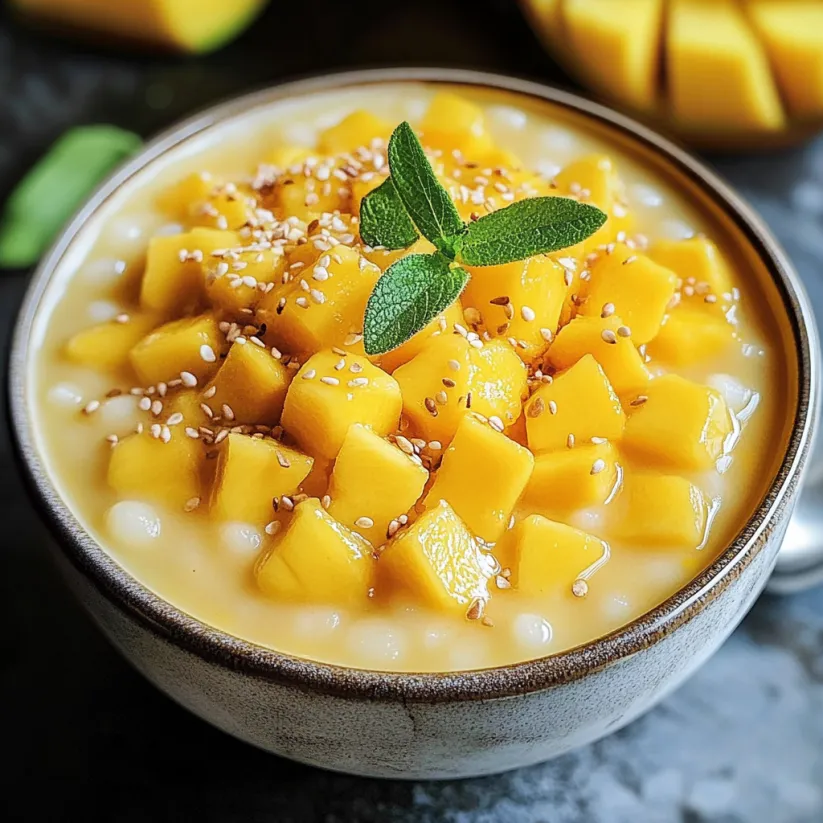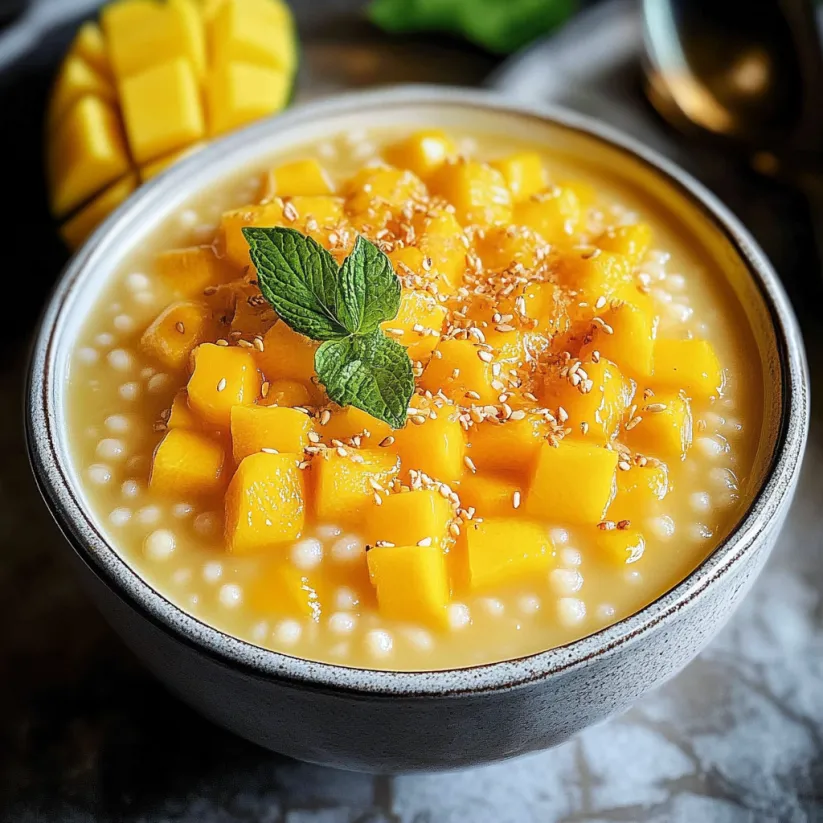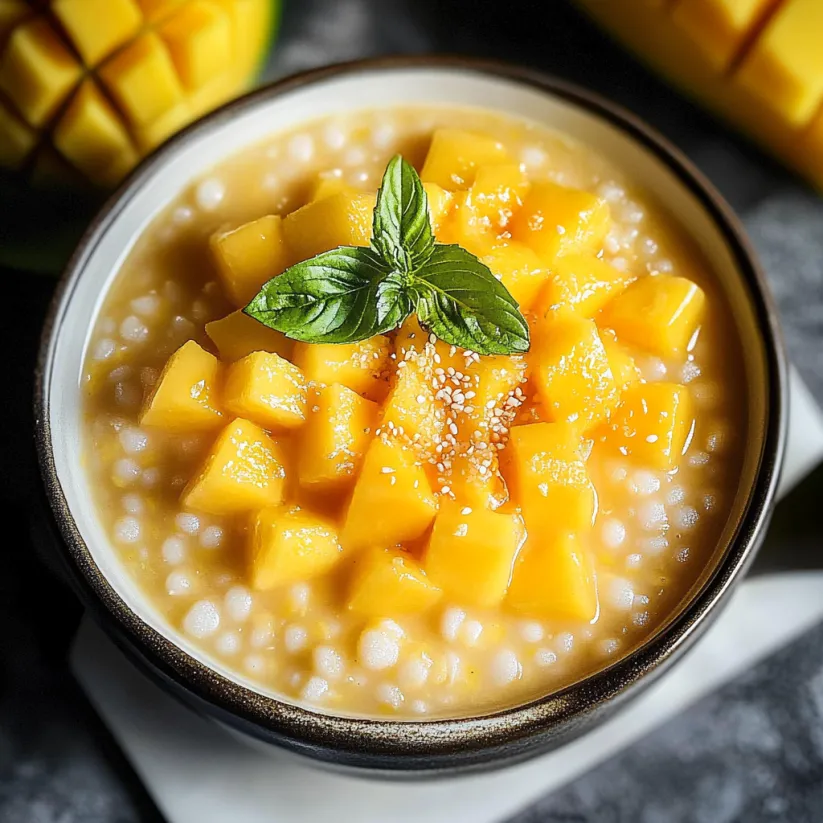 Save Pin
Save Pin
This creamy Mango Sago is a dessert I turn to every summer when mangoes are at their peak. The combination of sweet fruit, chewy tapioca pearls, and smooth coconut milk makes every bite cooling and irresistible. Perfect after a spicy meal or as a sweet midday treat, this is a classic loved throughout Asian households for good reason.
I first made this when fresh mangoes tumbled out of the produce drawer. My family now asks for it every mango season because it brings pure tropical happiness straight to our table.
Ingredients
- Ripe mangoes: The star ingredient Sweet mangoes like Ataulfo or Alphonso will give the richest flavor Choose fruit that gives slightly when pressed and smells fragrant
- Small tapioca pearls: Sago pearls create the luscious chewy texture Look for pearls that are uniform in size and avoid broken bits for an even cook
- Coconut milk: For that classic milky richness Select a brand with minimal additives and a thick creamy consistency
- Evaporated milk or regular milk: Adds extra creaminess and balances coconut Select evaporated milk for richness or whole milk for a lighter version
- Sugar: Adjust as needed to taste Granulated sugar blends in easily Taste your mangoes first since sweetness can vary
- Salt: Just a pinch It brings out the mango’s natural flavor
- Water: Helps the blending process go smoothly
- Extra mango cubes and mint leaves (Optional for topping): Adds fresh flavor and a pop of color Use ripe firm mango for the best garnish
Step-by-Step Instructions
- Cook the Sago:
- Bring a medium pot of water to a gentle simmer and add tapioca pearls while stirring to prevent sticking Let them cook for about 10 to 12 minutes or until most pearls turn translucent Stir occasionally to avoid clumping Drain the sago and rinse under cold water until completely cool to stop cooking and prevent them from sticking together
- Blend the Mango Base:
- Cut one and a half of your peeled mangoes into chunks Place these in a blender Add coconut milk evaporated or regular milk sugar salt and water Blend until you get a completely smooth and velvety texture Taste and adjust sweetness if needed
- Mix in the Sago:
- Fold the cooled tapioca pearls gently into the blended mango mixture Make sure everything is evenly combined and pearls are suspended throughout
- Chill Thoroughly:
- Pour the mixture into a bowl or container Cover and chill in the refrigerator for at least one hour Chilling sets the flavors and gives the dessert a luxuriously cool texture
- Serve with Toppings:
- Spoon the chilled mango sago into serving bowls or glasses Top with diced mango from the remaining half fruit and a few mint leaves if you like Serve immediately while everything is cold and refreshing
 Save Pin
Save Pin
When the mangoes are perfectly ripe I cannot resist making a double batch The way the sweet fruit melds with the creamy coconut reminds me of sunny trips to the tropics with my family We always fought for that last bowl
Storage Tips
Store leftovers in a covered container in the fridge for up to two days If the pearls soak up too much liquid just stir in a little extra coconut milk to loosen it up again Best enjoyed on the day it is made for the freshest texture
Ingredient Substitutions
If you have trouble finding sago small regular tapioca pearls work just as well For dairy free needs use only coconut milk and perhaps a splash of almond milk to thin as needed If you love extra richness swap sugar for condensed milk and reduce other sweeteners to taste
Serving Suggestions
For an elegant party dessert serve mango sago in little glass jars or shot glasses with a sprig of mint and a few fresh mango cubes Layering the mango mixture and sago for a parfait effect is a showstopper Try topping with a sprinkle of toasted coconut or even some pomelo pulp for a twist
 Save Pin
Save Pin
Cultural Context
Mango Sago’s origins trace to Hong Kong and Southeast Asia where it is a favorite finish after dim sum or festive meals It embodies the love for cooling desserts in hot climates Millions across the region have childhood memories of sharing bowls of this chilled treat with family
Commonly Asked Questions
- → What type of mango is best for this dessert?
Sweet, ripe varieties such as Ataulfo or Alphonso offer the smoothest texture and richest flavor.
- → Should the sago be rinsed after cooking?
Yes, rinse cooked sago under cold water to remove excess starch and achieve a pleasantly chewy texture.
- → Can condensed milk be used?
Condensed milk can be substituted for sugar and evaporated milk, resulting in a richer, creamier taste.
- → How long should the mixture chill?
Chill at least 1 hour so flavors meld and texture sets. Longer chilling enhances the refreshing quality.
- → How is this dessert typically served?
Serve cold in bowls or glasses, often topped with extra mango cubes and mint leaves for color and freshness.
